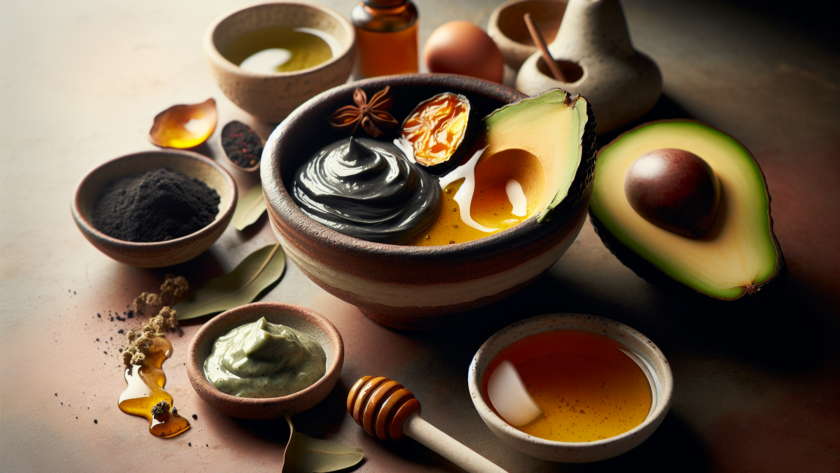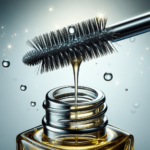If you’re looking for a fun and cost-effective way to pamper your skin, look no further than homemade face masks. Whether you want to target specific skin concerns or simply refresh your complexion, creating your own face masks can be both rewarding and relaxing. In this article, we’ll explore the art of making homemade face masks and guide you through the steps of achieving that natural, radiant glow you’ve always dreamed of. So gather your ingredients and get ready to embark on a self-care journey that will leave your skin feeling rejuvenated and your spirits lifted.
Types of Homemade Face Masks
When it comes to homemade face masks, there are various types that cater to different skin types and concerns. Understanding your skin type is essential in choosing the right mask that will not only address your specific needs but also provide optimal results. Here are some of the different types of homemade face masks:
Facial masks for oily skin
If you have oily skin, you know the struggle of dealing with excessive shine and frequent breakouts. Homemade face masks for oily skin focus on balancing oil production, unclogging pores, and reducing the appearance of acne. Ingredients like clay, apple cider vinegar, and tea tree oil are commonly used in these masks to control sebum production and promote clearer skin.
Facial masks for dry skin
Dry skin requires extra hydration and nourishment to combat dryness, flakiness, and dullness. Homemade face masks for dry skin aim to replenish moisture, soothe irritated skin, and improve overall hydration. Ingredients like honey, avocado, and almond oil are often utilized in these masks to provide intense hydration and restore the skin’s natural moisture barrier.
Facial masks for combination skin
Combination skin can be a bit tricky to deal with since it has both oily and dry areas. Homemade face masks for combination skin aim to balance oil production in the T-zone while providing adequate moisture to the dry areas. Ingredients like yogurt, oatmeal, and aloe vera are commonly used in these masks to address oily patches, soothe dry areas, and promote an overall balanced complexion.
Facial masks for acne-prone skin
Acne-prone skin requires special attention to prevent breakouts, reduce inflammation, and promote healing. Homemade face masks for acne-prone skin focus on deep cleansing, exfoliation, and controlling bacterial growth. Ingredients like turmeric, baking soda, and tea tree oil are often incorporated into these masks for their antibacterial and anti-inflammatory properties.
Facial masks for sensitive skin
Sensitive skin can be easily irritated and prone to redness and allergic reactions. Homemade face masks for sensitive skin aim to nourish and soothe the skin while avoiding harsh ingredients that may cause irritation. Ingredients like cucumber, aloe vera, and oatmeal are commonly used in these masks for their gentle and calming properties.
Natural Ingredients for Face Masks
One of the great things about homemade face masks is that they are made from natural ingredients readily available in your kitchen. These ingredients not only offer multiple skincare benefits but are also gentle on the skin. Here are some of the commonly used natural ingredients for homemade face masks:
Honey
Honey is a versatile ingredient that offers numerous benefits for the skin. It is a natural humectant, which means it helps retain moisture and keeps the skin hydrated. Honey also has antimicrobial properties, making it effective in combating acne and soothing irritated skin.
Yogurt
Yogurt is rich in lactic acid, which gently exfoliates the skin, promotes cell renewal, and brightens the complexion. It also contains probiotics that help balance the skin’s microbiome, making it an excellent ingredient for both oily and dry skin types.
Aloe vera
Aloe vera is well-known for its soothing and healing properties. It has anti-inflammatory effects that can reduce redness and calm irritated skin. Aloe vera also contains vitamins and antioxidants that help nourish and hydrate the skin, making it beneficial for all skin types.
Oatmeal
Oatmeal is a gentle exfoliant that can remove dead skin cells, unclog pores, and reduce inflammation. It has moisturizing properties that can soothe dry skin and alleviate itching or irritation. Oatmeal is particularly beneficial for sensitive and acne-prone skin.
Turmeric
Turmeric has been used for centuries in skincare due to its powerful antioxidant and anti-inflammatory properties. It can help brighten the skin, even out skin tone, and reduce the appearance of acne scars. However, it is important to note that turmeric can temporarily stain the skin, so a patch test is recommended before use.
Avocado
Avocado is packed with healthy fats, vitamins, and antioxidants that nourish and hydrate the skin. It helps improve skin elasticity, reduce fine lines, and promote a youthful complexion. Avocado also has anti-inflammatory properties, making it suitable for sensitive and dry skin types.
Lemon
Lemon is a natural astringent that can help tighten pores and control excess oil production. It has brightening properties that can fade dark spots and promote a more even skin tone. However, lemon juice can be drying, so it is important to dilute it with other ingredients or use it sparingly.
Cucumber
Cucumber is known for its cooling and hydrating properties. It has a high water content that helps moisturize the skin and reduce puffiness. Cucumber also contains antioxidants that can protect the skin against environmental damage and soothe irritation.
Coconut oil
Coconut oil is a deeply hydrating and nourishing ingredient that can improve skin elasticity and promote a healthy glow. It has antimicrobial properties that can help combat acne-causing bacteria and soothe inflamed skin. However, coconut oil may not be suitable for oily or acne-prone skin as it can clog pores.
Baking soda
Baking soda has exfoliating properties that can help remove dead skin cells, unclog pores, and reduce the appearance of blackheads. It can also balance the pH of the skin, preventing it from becoming too acidic or alkaline. However, baking soda can be abrasive, so it should be used with caution and in moderation.
Face Mask Recipes
Now that you’re familiar with the different types of homemade face masks and the natural ingredients you can use, let’s dive into some simple and effective face mask recipes. These recipes are easy to follow and can be customized based on your skin type and concerns.
Honey and Oatmeal Mask
This mask is perfect for dry or sensitive skin as it provides deep hydration and soothes irritation. Simply mix one tablespoon of honey with one tablespoon of finely ground oatmeal. Apply the mixture to your face, leave it on for 15-20 minutes, and then rinse off with warm water. Your skin will feel soft, nourished, and refreshed.
Yogurt and Turmeric Mask
This mask is great for brightening the complexion and reducing inflammation. Combine one tablespoon of plain yogurt with half a teaspoon of turmeric powder. Apply the mixture to your face, avoiding the eye area, and leave it on for 15-20 minutes. Rinse off with lukewarm water, and you’ll notice a radiant and glowing skin.
Aloe Vera and Cucumber Mask
This mask is ideal for soothing irritated skin and reducing redness. Blend half a cucumber and mix it with two tablespoons of aloe vera gel. Apply the mixture to your face and let it sit for 15-20 minutes. Rinse off with cool water, and your skin will feel calm and refreshed.
Avocado and Honey Mask
This mask is perfect for nourishing and moisturizing dry skin. Mash half a ripe avocado and mix it with one tablespoon of honey. Apply the mixture to your face, leave it on for 15-20 minutes, and then rinse off with warm water. Your skin will be hydrated, soft, and plump.
Lemon and Baking Soda Mask
This mask is helpful in exfoliating the skin and brightening the complexion. Mix one tablespoon of lemon juice with one teaspoon of baking soda. Apply the mixture to your face, gently massaging in circular motions for a minute or two. Leave it on for 5-10 minutes, then rinse off with warm water. Your skin will feel smooth, refreshed, and noticeably brighter.
Coconut Oil and Honey Mask
This mask is great for moisturizing and softening the skin. Combine one tablespoon of coconut oil with one tablespoon of honey. Apply the mixture to your face, massaging it gently with your fingertips. Leave it on for 10-15 minutes, then rinse off with warm water. Your skin will feel deeply nourished and supple.
Oatmeal and Yogurt Mask
This mask is gentle yet effective in calming irritated skin and reducing redness. Mix two tablespoons of cooked oatmeal with one tablespoon of plain yogurt. Apply the mixture to your face, leave it on for 15-20 minutes, and then rinse off with warm water. Your skin will feel soothed and comfortable.
Turmeric and Coconut Oil Mask
This mask is beneficial for brightening the skin and fading dark spots. Combine one teaspoon of turmeric powder with one tablespoon of coconut oil. Apply the mixture to your face, avoiding the eye area, and leave it on for 15-20 minutes. Rinse off with lukewarm water, and your skin will appear more radiant and even-toned.
Aloe Vera and Lemon Mask
This mask is great for oily or acne-prone skin as it helps control oil production and reduce acne. Mix two tablespoons of aloe vera gel with one tablespoon of freshly squeezed lemon juice. Apply the mixture to your face, leaving it on for 10-15 minutes, and then rinse off with cool water. Your skin will feel refreshed and balanced.
Cucumber and Honey Mask
This mask is excellent for hydrating and refreshing the skin. Blend half a cucumber and mix it with one tablespoon of honey. Apply the mixture to your face and let it sit for 15-20 minutes. Rinse off with cool water, and your skin will feel hydrated, revitalized, and rejuvenated.
Preparing Your Face Mask
Now that you have your chosen face mask recipe ready, it’s important to prepare it properly for optimal results and safety. Here are some key steps to follow when preparing your face mask:
Gathering the ingredients
Collect all the ingredients mentioned in the recipe and make sure they are fresh and of good quality. Using high-quality ingredients will ensure that your mask is effective and safe for your skin.
Measuring and mixing the ingredients
Measure the ingredients accurately according to the recipe. In some cases, proportions may need to be adjusted to achieve the desired consistency. Mix the ingredients thoroughly to create a smooth and well-blended mask.
Ensuring proper hygiene
Before starting the preparation, make sure your hands and all utensils are clean and sanitized. Bacteria or dirt on your hands or the utensils can contaminate the mask, leading to skin irritation or infection.
Using organic and high-quality ingredients
Opting for organic ingredients whenever possible is a great way to ensure that your mask is free from harmful chemicals or pesticides. Look for high-quality ingredients that are free from additives or artificial fragrances.
Adjusting consistency if needed
Depending on the recipe, you may need to adjust the consistency of your mask. If the mixture is too thick, you can add a few drops of water or aloe vera gel to thin it out. Conversely, if it’s too runny, you can add a bit more of the main ingredient to thicken it up.
Application Techniques
Applying your homemade face mask correctly is crucial to get the maximum benefits and avoid any potential skin issues. Here are some tips on how to properly apply your face mask:
Washing and cleansing your face
Start by thoroughly washing your face with a gentle cleanser to remove any dirt, oil, or makeup. Cleansing your face ensures that the mask can penetrate the skin effectively and work its magic.
Steam treatment before applying the mask
For better absorption and to open up your pores, you can indulge in a steam treatment before applying the mask. Boil some water, pour it into a bowl, and hold your face over the steam for a few minutes. This will help soften your skin and prepare it for the mask.
Using a brush, sponge, or fingers to apply
You have the option to apply your face mask with a brush, sponge, or your clean fingertips. A brush or a sponge can provide a more even application, while fingers allow for better control and precision.
Applying the mask evenly and avoiding the eye area
Apply the mask evenly, making sure to cover your entire face, excluding the delicate eye area. Be gentle and avoid tugging or pulling on your skin. Applying the mask evenly ensures that all areas of your face receive the benefits.
Leaving the mask on for the recommended time
Refer to the recipe instructions for the recommended time to leave the mask on. It is important not to exceed the recommended duration as leaving the mask on for too long can cause dryness or irritation. Set a timer to track the time accurately.
Removing the mask with warm water
When it’s time to remove the mask, rinse your face with warm water. Gently massage the mask with your fingertips while rinsing to ensure thorough removal. Avoid using hot water, as it can strip the skin of its natural oils.
Following up with toner and moisturizer
After removing the mask, it’s essential to follow up with a toner and moisturizer to seal in the benefits. Use a toner to balance the skin’s pH and a moisturizer to hydrate and nourish the skin. Choose products that are suitable for your skin type.
Frequency and Timing
Determining how often to use face masks depends on several factors, including your skin type, concerns, and the specific mask you are using. It is important to listen to your skin and adjust the frequency accordingly. Here are some factors to consider:
Determining how often to use face masks
For most skin types, using a face mask once or twice a week is sufficient. However, if you have oily or acne-prone skin, you may benefit from using a mask more frequently, such as every other day. On the other hand, if you have sensitive or dry skin, it’s best to use masks less often, such as once every ten days.
Considering your skin type and concerns
Take into account your specific skin type and concerns when deciding on the frequency of using face masks. Oily skin types may find it beneficial to use a clay mask more frequently to control excess oil, while dry skin types might prefer a hydrating mask less frequently to avoid over-moisturizing.
Following a regular skincare routine
Incorporating face masks into your regular skincare routine ensures that you give your skin the necessary attention it needs. It complements other skincare steps, such as cleansing, toning, and moisturizing, and can enhance their effectiveness.
Timing the application for optimal effectiveness
Timing your face mask application is crucial for optimal effectiveness. Consider applying your mask in the evening when you have ample time to relax and let the mask work its magic without rushing. This way, you can fully enjoy the experience and benefit from the results.
Storage and Shelf Life
Proper storage is essential to maintain the freshness and effectiveness of your homemade face masks. Here are some key points to keep in mind:
Storing homemade face masks
After preparing your face mask, store it in a clean, airtight container to prevent contamination and keep it fresh. Avoid storing masks in transparent containers, as exposure to light can degrade certain ingredients.
Using clean and airtight containers
Cleanliness is crucial when it comes to storing face masks. Make sure the container you use is thoroughly cleaned and dried before transferring your mask into it. Airtight containers help preserve the mask’s freshness and prevent exposure to air and bacteria.
Checking for signs of spoilage
Homemade face masks utilize natural ingredients, and their shelf life can vary. It is important to check for any signs of spoilage before each use. Look for changes in color, texture, or odor, as these can indicate that the mask has gone bad.
Discarding expired or spoiled masks
If you notice any signs of spoilage or if your mask has expired, it is best to discard it. Using an expired or spoiled mask can lead to skin irritation, infections, or ineffectiveness. Prioritize safety and always opt for fresh and properly stored masks.
Precautions and Allergies
While homemade face masks are generally safe and beneficial, it is important to take certain precautions, especially if you have sensitive skin or known allergies. Here are some precautions to keep in mind:
Performing a patch test before using a new ingredient
If you are using a new ingredient or recipe for the first time, it is recommended to perform a patch test. Apply a small amount of the mask on an inconspicuous area, such as the inner arm, and leave it on for 24 hours. If any redness, itchiness, or irritation occurs, refrain from using the mask on your face.
Being cautious with strong or potentially irritating ingredients
Some ingredients, such as lemon juice or essential oils, can be strong or potentially irritating to the skin. It is important to dilute these ingredients properly and use them in moderation. Always follow the recommended proportions in the recipe and be mindful of your skin’s reaction.
Avoiding masks if you have open wounds or skin infections
If you have open wounds, cuts, or skin infections, it is best to avoid using face masks until the skin has fully healed. Applying masks to compromised skin can worsen the condition or delay the healing process. Prioritize the health and safety of your skin.
Consulting a dermatologist for specific concerns or allergies
If you have specific skin concerns or known allergies, it is advisable to consult a dermatologist. They can provide personalized advice and recommendations based on your skin type and concerns. A dermatologist can also help determine if certain ingredients or masks are safe for your skin.
Benefits of Homemade Face Masks
There are numerous benefits to incorporating homemade face masks into your skincare routine. Here are some key advantages:
Nourishing the skin with natural and wholesome ingredients
Homemade face masks allow you to nourish your skin with natural and wholesome ingredients. By using ingredients like honey, yogurt, aloe vera, and avocado, you are providing your skin with essential nutrients, vitamins, and antioxidants that promote healthy and radiant skin.
Saving money compared to store-bought masks
Making your own face masks can save you money compared to purchasing store-bought masks. Many commercial masks contain additives, preservatives, and fillers that can increase their price. By using affordable and easily accessible ingredients, you can enjoy the benefits of a face mask without breaking the bank.
Tailoring the mask to your specific skin needs
With homemade face masks, you have the freedom to customize the ingredients to cater to your specific skin needs. You can adjust the ingredients, proportions, and consistency to address concerns like dryness, oiliness, acne, or sensitivity. This personalization ensures that you are targeting your specific skin concerns effectively.
Avoiding harsh and potentially harmful chemicals
Commercial face masks often contain harsh chemicals, artificial fragrances, and preservatives that may be harmful to the skin. Homemade face masks enable you to avoid these potentially irritating or toxic ingredients. By using natural and organic ingredients, you can be confident that you are treating your skin with care.
Enjoying a relaxing and pampering self-care activity
Using homemade face masks is not only beneficial for your skin but also provides a relaxing and pampering self-care activity. Taking the time to indulge in a face mask allows you to unwind, de-stress, and focus on self-care. The simple act of applying a mask and giving yourself some much-needed TLC can boost your mood and overall well-being.
Conclusion
Homemade face masks offer a wide range of benefits for your skin and provide a fun and customizable skincare experience. Whether your skin is oily, dry, combination, acne-prone, or sensitive, there is a homemade face mask recipe suited to your needs. By utilizing natural ingredients like honey, yogurt, aloe vera, oatmeal, turmeric, avocado, lemon, cucumber, coconut oil, and baking soda, you can nourish and pamper your skin without the use of harsh chemicals. Remember to properly prepare your face masks, apply them correctly, and consider the frequency and timing that works best for your skin type. By incorporating homemade face masks into your skincare routine, you can enjoy healthier, glowing, and more radiant skin. So, go ahead, mix up your favorite face mask recipe, sit back, and indulge in some well-deserved self-care. Your skin will thank you for it!




